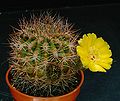Acanthocalycium thionanthum
 From Wikipedia the free encyclopedia
From Wikipedia the free encyclopedia
| Acanthocalycium thionanthum | |
|---|---|
 | |
| Scientific classification | |
| Kingdom: | Plantae |
| Clade: | Tracheophytes |
| Clade: | Angiosperms |
| Clade: | Eudicots |
| Order: | Caryophyllales |
| Family: | Cactaceae |
| Subfamily: | Cactoideae |
| Genus: | Acanthocalycium |
| Species: | A. thionanthum |
| Binomial name | |
| Acanthocalycium thionanthum (Speg.) Backeb. 1935 | |
| Synonyms | |
| |
Acanthocalycium thionanthum is a species of Acanthocalycium from Argentina.[1]
Description[edit]
Acanthocalycium thionanthum usually grows individually with spherical to short cylindrical, dark green to green-grey shoots and reaches a height of up to 12 centimeters with a diameter of 10 centimeters. There are 9 to 15 round ribs that are slightly notched and bumpy. From the elliptical areoles arise submissive, gray thorns that have a darker tip. There are 1 to 4 central spines, which can also be absent, and 5 to 10 radial spines.
The somewhat bell-shaped flowers are bright yellow to red or white. They have a length of up to 4.5 centimeters and have the same diameter. Your pericarpel and the flower tube are covered with dark pointed scales and brown to white hair and bristles. The spherical, hard-fleshed fruits tear open and reach a diameter of up to 1 centimeter.[2]
Subspecies[edit]
Recognized subspecies:[3]
| Image | Scientific name | Distribution |
|---|---|---|
 | Acanthocalycium thionanthum subsp. glaucum (F.Ritter) Lodé | Argentina |
 | Acanthocalycium thionanthum subsp. ferrarii (Rausch) Schlumpb. | Argentina (Tucumán). |
 | Acanthocalycium thionanthum subsp. thionanthum | Argentina |
Distribution[edit]
Acanthocalycium thionanthum is widespread in the Argentine provinces of Salta, Tucumán and Catamarca at altitudes of 1500 to 3000 meters.
Taxonomy[edit]
The first description as Echinocactus thionanthus by Carlos Luis Spegazzini was published in 1905.[4] Curt Backeberg placed the species in the genus Acanthocalycium in 1936.[5] The specific epithet thionanthum is derived from the Greek words theion for 'sulfur' and anthos for 'flower' and refers to the flower color of the species. Further nomenclature synonyms are Lobivia thionantha (Speg.) Britton & Rose (1922), Echinopsis thionantha (Speg.) Werderm. (1931) and Echinopsis thionantha (Speg.) D.R.Hunt (1987).
References[edit]
- ^ "Acanthocalycium thionanthum in Tropicos".
- ^ Anderson, Edward F.; Eggli, Urs; Anderson, Edward F. (2005). Das große Kakteen-Lexikon (in German). Stuttgart (Hohenheim): Ulmer. p. 68. ISBN 3-8001-4573-1.
- ^ "Acanthocalycium thionanthum (Speg.) Backeb. — Plants of the World Online". Plants of the World Online. Retrieved 2023-09-17.
- ^ Aires., Museo Nacional de Buenos (1905). "Anales del Museo Nacional de Buenos Aires". Impr. de Juan A. Alsina. Retrieved 2023-09-17.
- ^ "Au Cactus Francophone :". Au Cactus Francophone (in French). Retrieved 2023-09-17.
External links[edit]
 Media related to Acanthocalycium thionanthum at Wikimedia Commons
Media related to Acanthocalycium thionanthum at Wikimedia Commons Data related to Acanthocalycium thionanthum at Wikispecies
Data related to Acanthocalycium thionanthum at Wikispecies